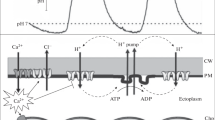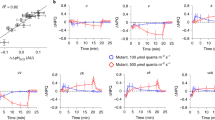Summary
The proton-driven ATP synthase of chloroplasts is composed of two elements, CF0 and CF1. The membrane bound CF0 conducts protons and the peripheral CF1 interacts with nucleotides. By flash spectrophotometric techniques applied to thylakoid membranes from which about 50% of total CF1 was removed, we have previously determined the protonic (timeaveraged) single-channel conductance of CF0. Being in the order of 1 pS, it was sufficiently large to support the proposed role of CF0 as a low-impedance access for protons to the coupling site in CF0CF1. On the other hand, it was too large to be readily reconciled with current concepts of proton supply to and proton conduction through the channel.
We studied the time-averaged single-channel conductance of CF0 under variation of pH, pD, ionic composition, temperature, and water/membrane structure with the following results: (i) CF0 was proton-specific even against a background of 300mm monovalent or 30mm divalent catins. (ii) While the conductance of CF0 was pH/pD-independent in the range from 5.6–8.0, in D2O it was lower by a constant factor of 1.7 than in H2O (iii) Addition of glycerol diminished the conductance and abolished the isotope effect. (iv) The Arrhenius activation energy was 42 kJ/mol and thus intermediate between the ones found for the water-filled pore, gramicidin (30 kJ/mol), and the mobile carrier, valinomycin (65 kJ/mol).
The results implied that CF0 is endowed with an extremely proton-specific (107-fold) selectivity filter. Its conductance is very high, and its conduction cycle is not necessarily rate limited by a protolytic reaction. The mechanisms of rapid proton supply to the channel mouth and of proton conduction remained enigmatic.
Similar content being viewed by others
References
Ausländer, W., Junge, W. 1975. Neutral red, a rapid indicator for pH-changes in the inner phase of thylakoids.FEBS Lett. 59:310–315
Benz, R., Stark, G., Janko, K., Läuger, P. 1973. Valinomycinmediated ion transport through neutral lipid membranes: Influence of hydrocarbon chain length and temperature.J. Membrane Biol. 14:339–364
Boyer, D.B. 1988. Bioenergetic coupling to protonmotive force: Should we be considering hydronium ion coordination and not group protonation?Trends Biochem. Sci. 13:5–7
Brünger, A., Schulten, Z., Schulten, K. 1983. A network thermodynamic investigation of stationary and nonstationary proton transport through proteins.Z. Phys. Chem. 136:1–63
Cadenhead, D.A., Bean, K.E. 1972. Selected lipid monolayers on aqueous-glycerol and aqueous-urea substrates.Biochim. Biophys. Acta 290:43–50
Caceci, M.S., Cacheris, W.P. 1984. Fitting curves to data. The simplex algorithm is the answer.Byte Mag. 9:340–362
Davenport, J.W., McCarty, R.E. 1981. Quantitative aspects of adenosine triphosphate-driven proton translocation in spinach chloroplast thylakoids.J. Biol. Chem. 256:8947–8954
Dibrov, P.A., Lazarova, V.P., Skulachev, V.P., Verkhovskaya, M.L. 1986. The sodium cycle: II. Na+-coupled oxidative phosphorylation inVibrio alginolyticus cells.Biochim. Biophys. Acta 850:458–465
Dimroth, P. 1987. Sodium ion transport decarboxylases and other aspects of sodium ion cycling in bacteria.Microbiol. Rev. 31:320–340
Dunker, A.K., Marvin, D.A. 1978. A model for membrane-transport through α-helical protein pore.J. Theor. Biol. 72:9–16
Förster, V., Hong, Y.Q., Junge, W. 1981. Electron transfer and proton pumping under excitation of dark adapted chloroplasts with flashes of light.Biochim. Biophys. Acta 638:141–152
Förster, V., Junge, W. 1985. Stoichiometry and kinetics of proton release upon photosynthetic water oxidation.Photochem. Photobiol. 41:183–190
Hille, B. 1984. Ionic channels of excitable membranes. Sinauer Associated, Sunderland, Mass.
Hladky, S.B., Haydon, D.A. 1972. Ion transfer across lipid membranes in the presence of gramicidin A.Biochim. Biophys. Acta 274:294–312
Junesch, U., Gräber, P. 1985. The rate of ATP synthesis as a function of Δ pH in normal and dithiothreitol-modified chloroplasts.Biochim. Biophys. Acta 809:429–434
Junge, W. 1976. Fash kinetic spectrophotometry in the study of plant pigments.In: Chemistry and Biochemistry of Plant Pigments. Vol. II, pp. 233–333. T.W. Goodwin, editor. Academic, New York
Junge, W. 1982. Electrogenic reactions and proton pumping in green plant photosynthesis.Curr. Top. Membr. Transp. 16:431–465
Junge, W. 1987. Complete tracking of transient proton flow through active chloroplast ATP synthase.Proc. Natl. Acad. Sci. USA 48:7084–7088
Junge, W., Ausländer, W. 1973. The electric generator in photosynthesis of green plants.Biochim. Biophys. Acta 333:59–70
Junge, W., Ausländer, W., McGeer, A.J., Runge, T. 1979. The buffering capacity to the internal phase of thylakoids and the magnitude of the pH-changes inside under flashing light.Biochim. Biophys. Acta 546:121–141
Junge, W., Polle, A. 1986. Theory or proton flow along appressed thylakoid membranes under instationary and under stationary conditions.Biochim. Biophys. Acta 848:265–273
Junge, W., Rumberg, B., Schröder, H. 1970. The necessity of an electric potential difference and its use for photophosphorylation in short flash groups.Eur. J. Biochem. 14:575–581
Junge, W., Witt, H.T. 1968. On the ion transport system of photosynthesis. Investigations on a molecular level.Z. Naturforsch. 38:244–254
Kasianowicz, J., Benz, R., McLaughlin, S. 1987. How do protons cross the membrane-solution interface? Kinetic studies on bilayer membranes exposed to the protonophroe S-13 (5-chloro-3-tert-butyl-2′-chloro-4′-nitrosalicylanilide).J. Membrane Biol. 95:73–89
Latorre, R., Miller, C. 1983. Conduction and selectivity in potassium channels.J. Membrane Biol. 71:11–30
Lear, J.D., Wassermann, Z.R., DeGrado, W.F. 1988. Synthetic amphiphilic peptide models for protein ion channels.Science 240:1177–1181
Lill, H., Althoff, G., Junge, W. 1987. Analysis of ionic channels by a flash spectrophotometric technique applicable to thylakoid membranes: CF0, the proton channel of the chloroplast ATP synthase, and for comparison, gramicidin.J. Membrane Biol. 98:69–78
Lill, H., Engelbrecht, S., Schönknecht, G., Junge, W. 1986. The proton channel, CF0, of thylakoid membranes. Only a low proportion of CF1-lacking CF0 is active with a high unit conductance (169 fS).Eur. J. Biochem. 160:627–634
Lill, H., Junge, W. 1989. CF0 the proton channel of chloroplast ATP synthase.Eur. J. Biochem. 179:459–467
Mitchell, P. 1977. A commentary on alternative hypothesis of proton coupling in the membrane systems catalysing oxidative and photosynthetic phosphorylation.FEBS Lett. 78:1–20
Nagle, J.F., Morowitz, H.J. 1978. Molecular mechanism for proton transport in membranes.Proc. Natl. Acad. Sci. USA 75:298–302
Nagle, J.F., Tristram-Nagle, S. 1983. Hydrogen bonded chain mechanisms for proton conduction and proton pumping.J. Membrane Biol. 74:1–14
Neher, E., Sakmann, B. 1976. Single-channel currents recorded from membrane of denervated frog muscle fibres.Nature (London) 260:779–802
Neher, E., Sandblom, J., Eisenmann, G. 1978. Ionic selectivity, saturation, and block in gramicidin A channels.J. Membrane Biol. 40:97–116
Parsegian, A. 1969. Energy of an ion crossing a low dielectric membrane: Solutions to four relevant electrostatic problems.Nature (London) 221:844–846
Polle, A., Junge, W. 1986. The slow rise of the flash-induced alkalization by Photosystem II of the suspending medium is reversibly related to thylakoid stacking.Biochim. Biophys. Acta 848:257–264
Prats, M., Tocanne, J.F., Teissie, J. 1987. Lateral proton conduction at a lipid/water interface. Effect of lipid nature and ionic content of the aqueous phase.Eur. J. Biochem. 162:379–385
Schmid, R., Junge, W. 1975. Current-voltage studies on the thylakoid membrane in the presence of ionophores.Biochim. Biophys. Acta 394:76–92
Schneider, E., Altendorf, K. 1987. Bacterial adenosine 5′-triphosphate synthase (F1F0): Purification and reconstitution of F0 complexes and functional characterization of their subunits.Microbiol. Rev. 51:477–497
Schönknecht, G., Junge, W., Lill, H., Engelbrecht, S. 1986. Complete tracking of proton flow in thylakoids-the unit conductance of CF0 is greater than 10 fS.FEBS Lett. 203:289–294
Schulten, Z., Schulten, K. 1985. A model for the resistance of the proton channel formed by the proteolipid of ATPase.Eur. Biophys. J. 11:149–155
Senior, A.E. 1988. ATP synthesis by oxidative phosphorylation.Physiol. Rev. 68:177–231
Sigrist-Nelson, K., Sigrist, H., Azzi, A. 1978. Characterization of the dicyclohexylcarbiodiimide binding protein isolated from chloroplast membranes.Eur. J. Biochem. 92:9–14
Wescott, C.C. 1978. pH Measurements. Academic, New York
Witt, H.T. 1979. Energy conversion in the functional membrane of photosynthesis. Analysis by light pulse and electric pulse methods. The central role of the electric field.Biochim. Biophys. Acta 505:355–427
Wolff, C., Buchwald, H.E., Rüppel, H., Witt, K., Witt, H.T. 1969. Rise time of the light induced electrical field across the function membrane of photosynthesis.Z. Naturforsch. 24:1038–1041
Author information
Authors and Affiliations
Rights and permissions
About this article
Cite this article
Althoff, G., Lill, H. & Junge, W. Proton channel of the chloroplast ATP synthase, CF0: Its time-averaged single-channel conductance as function of pH, temperature, isotopic and ionic medium composition. J. Membrain Biol. 108, 263–271 (1989). https://doi.org/10.1007/BF01871741
Received:
Issue Date:
DOI: https://doi.org/10.1007/BF01871741




